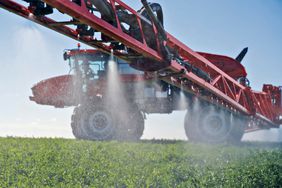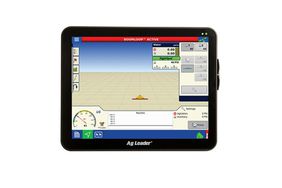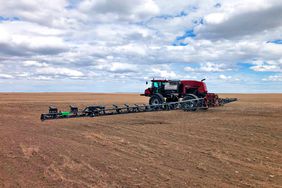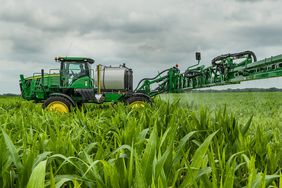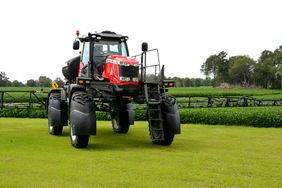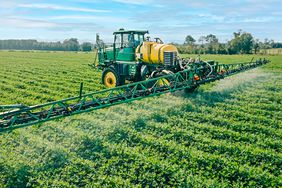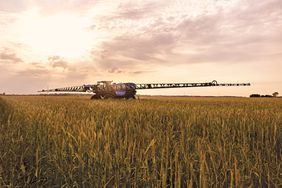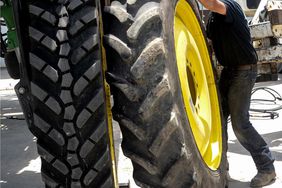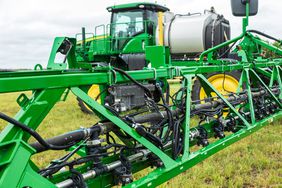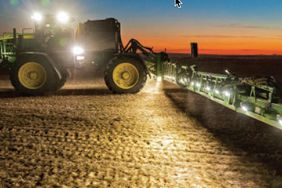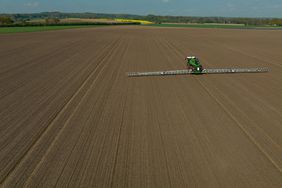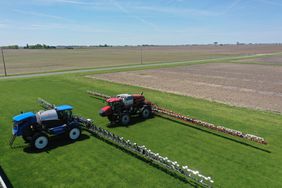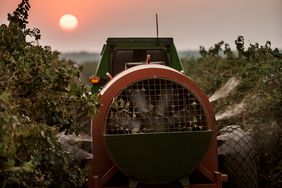:max_bytes(150000):strip_icc()/hagie-sprayer-2-4903c336b50a4a43a66dc684da67db69.jpg)
While sprayers were once a niche product, today sprayers have become an essential piece of farm equipment for effective crop production. By properly applying chemicals to control weeds, insects, and diseases, you give your crop the best chance for high yields.
The uptick in self-propelled sprayer ownership started in 2005 when there was an increase in Asian soybean rust and farmers needed to have a sprayer available to make timely fungicide applications. Guidance systems and advanced controls have also made sprayers much easier to operate, contributing to the acceleration of on-farm sprayers.
On this page, you'll find maintenance information, spraying tips, a listing of ag sprayer manufacturers, and details on self-propelled sprayers as well as ATV sprayers.
Sprayer Maintenance
First and foremost, you need to make sure your sprayer is in top condition before spring and then maintain your sprayer throughout the growing season.
Sprayer maintenance includes checking fluid levels, greasing necessary components, calibrating the sprayer monitor, and more. This sprayer maintenance checklist breaks down what you need to do before you start spraying as well as daily, weekly, and monthly maintenance upkeep during the season.
At the end of the year, it's important to do one final round of maintenance to winterize your sprayer. This will help protect your sprayer from frost damage and make sure it's ready to go for the next year. This article gives five tips for winterizing your sprayer, including flushing the system, scrutinizing the exterior, and cleaning the cab.
Spraying Tips
There are multiple steps you can take each time you spray to optimize efficiency and minimize off-target drift. It's essential to read the label, pick the best spray nozzle, calibrate your sprayer, and check wind speed. You should also use a spray-pattern check to make sure you have the right nozzle spacing and boom height. Get more spraying tips in this article on 16 steps to better spraying.
There is a small margin of error when it comes to spraying pesticides, both for increasing efficiency and protecting neighboring fields. For more effective and safe spraying, remember that small drops take time to hit the target, droplet size depends on pressure, small droplets dry quickly, and that nozzles produce a variety of droplet sizes.
Self-Propelled Sprayers
In 1947, Ray Hagie, founder of Hagie Manufacturing, invented the world's first self-propelled sprayer. This revolutionary piece of equipment would change how farmers and professional applicators apply pesticides. Today, self-propelled sprayers make up the majority of the farm spraying market, having largely replaced pull-type sprayers.
Sprayers continue to get more sophisticated with advanced technology like auto guidance, auto shutoffs, and Y-Drop. In this article, Illinois farmer Jeff Brown details how he uses technology to ensure that every drop applied to his plants is delivered when and where the plant needs it most.
If you're in the market for a late-model self-propelled sprayer, be warned that low-hour sprayers are bringing higher prices on dealer lots and at auctions. Successful Farming's 2018 price projection for 3- to 4-year old sprayers shows a 4% increase. See more late-model, low-hour equipment price projections in our latest Machinery Insider column.
Agricultural Sprayer Manufacturers
A number of equipment manufacturers make self-propelled sprayers, including John Deere, Hagie, Hardi, Case IH, New Holland, AGCO, and Equipment Technologies.
In 2017, John Deere introduced a 123-foot, carbon-fiber boom – its widest boom to date. The new boom was accompanied by the freshly designed CommandView III Cab, which features a hydro handle joystick, a 4600 Command Center display, and a redesigned CommandARM.
New Holland, AGCO, Hardi, and Equipment Technologies also introduced new sprayer models last year. New Holland introduced the Guardian SP310F and Miller Nitro 7310 – the first since New Holland acquired Miller-St. Nazianz. AGCO unleashed the RoGator C series with Liquid Logic, which helps to reduce off-target applications. Hardi came out with the Rubicon 9000. The 380-hp. Rubicon 9000 has a 2,200-gallon payload and booms up to 160 feet to cover 330 acres per hour. Last, Equipment Technologies reengineered its self-propelled hydrostatic sprayers for the North American market.
At the end of 2016, John Deere and Hagie introduced the STS16 – the first product collaboration between the companies since Deere's acquisition of Hagie. The 2017 STS16 features a 9-liter John Deere PowerTech PSS engine.
ATV Sprayers
For field borders, pastures, fence lines, and other hard-to-spray areas, ATV sprayers are ideal for spot spraying. These sprayers can come equipped with a spray wand or a boom, depending on the location you're spraying. There are multiple options available for ATV boom sprayers, such as a steel, poly, or versatile boom.
Before you buy an ATV sprayer, consider how frequently you will use the sprayer, where you will spray, and how much you'd like to spend. This buyers' guide gives advice on key ATV sprayer features, including pumps, drainable tanks, seat pressure control, and liftability.
:max_bytes(150000):strip_icc()/Jessie-Scott-e5d5c2e8613948b4a0b503787be9d971.jpg)
